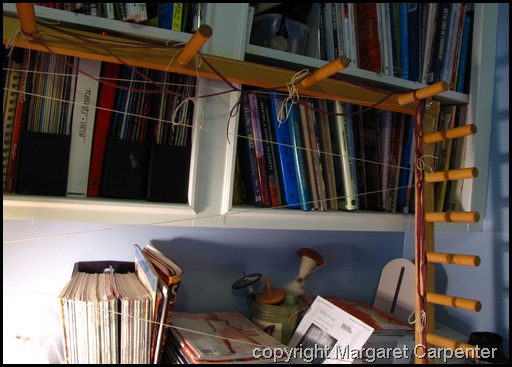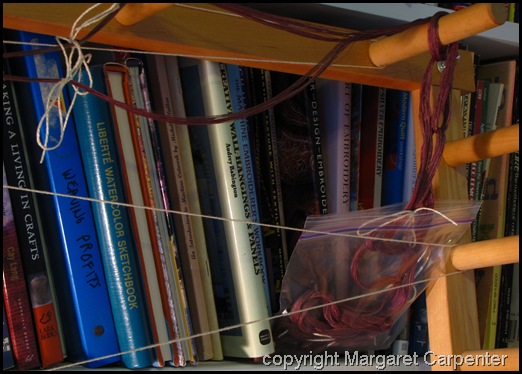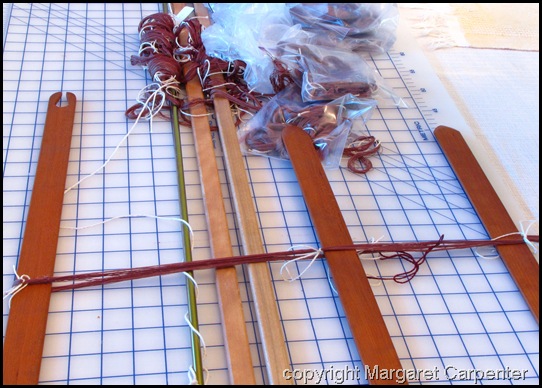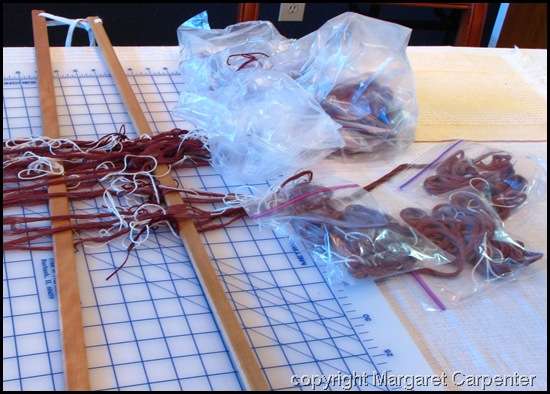Posted by
Peg in South Carolina
OTHER BLOGGERS
For a while, now, I have been fascinated by the daily project phenomenon on blogs. I have seen this in art blogs, with people painting or drawing a picture a day. I have seen it on photography blogs where people fully finish a photo a day. I have seen it on fiber blogs where people do a small surface design piece each day. And I have even seen it on weaving blogs.
I have followed Janet Dawson’s
Scarf-a-day blog with great interest and admiration. Though this doesn’t mean that she puts on a warp a day, it still has been a very ambitious (and successful!) project for her.
I have also followed Tommye Scanlin’s tapestry-a-day on her blog
Works in Progress. She doesn’t actually weave a whole tapestry each day. Rather, she put on a long but narrow tapestry warp and then each day wove in a building. She has been recording her progress in the side bar of her blog. Tommye called her piece a tapestry diary for the year 2009.
If I had a second loom, I could put on a long crackle warp and weave a sample a day. But, I don’t have another loom. So, what could I do?
A friend suggested I already have a project not unlike this since I do something weaving-related every day. But I want to do something that will notch my growth as a weaver up a bit more.
SOFTWARE TO THE RESCUE
Weaving software, I thought. At first I kind of cringed since fiddling with weaving software is definitely not weaving. Then about a week ago I woke up with the brilliant idea (ideas in the middle of the night always seem to be “brilliant”…….!)of exploring crackle drafts. So, here is what I am going to do.
A NEW E-SKETCHBOOK
I have started called a new E-sketchbook called “A Crackle Draft Project 2010.” I have put a shortcut to it on my computer desktop. Each day (for five days a week) I will put in a new crackle draft.
I will begin with the very simplest of drafts, a straight draw 4-shaft crackle threading with standard twill tie-up. I will explore each day a new way of developing and altering this very simple draft. Some explorations will be very simple and take very little time. Others will be more complex.
I will move from there to other threading possibilities and then on to six- and eight-shaft threadings of all kinds. Everything is subject to investigation: threading, tie-up, treadling, color, texture….
WIF FILES
At the same time, I have started a folder on my computer called by the same name and will include in that folder all the drafts as WIF files that I will place in my E-sketchbook. I will try to remember with each entry in my E-sketchbook to include the location of the draft in my computer folder.
If I save these drafts as WIF files, why, then, bother putting them in an E-Sketchbook?
In the E-Sketchbook I can make comments.
COMPUTER DRAFTS AND PENCIL SKETCHES
There is, of course, a limit to what can be accomplished in terms of design with weaving software. But I can think of them as the painter’s equivalent of pencil sketches. Many artists have kept reams of pencil or pen-and-ink sketches they made, either for fun or as preparations for a final painting. Weaving software provides the equivalent kind of experience in weaving design.
"Something-A-Day Project” was written by
Margaret Carpenter for
Talking about Weaving and was originally posted on January 1, 2010. ©2009 Margaret Carpenter aka Peg in South Carolina.



























